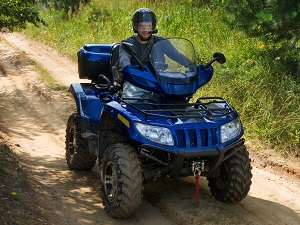If all-terrain vehicles (ATVs) are provided for workers to use on the job, they should be safe, and training should be provided.

The majority of ATV incidents result from:
- Loss of control of the vehicle
- ATV rollovers
- Operators being thrown from the vehicle
- ATVs colliding with a tree or other obstacles
- Operators not wearing a helmet or other protective equipment
- Inexperienced operators
Even though the moving parts of an ATV are covered, entanglement with moving parts or accidental contact with objects can cause severe injuries. Personal protective equipment (PPE) and clothing can reduce the severity of ATV-related incidents.
Wear helmets or other adequate head protection. Bicycle helmets do not provide sufficient face and head protection and absorb little energy. Wear protective clothing, including gloves, non-skid shoes, goggles, or face shields, long pants, and long sleeves.
Secure loose bootlaces that can become entangled in a spinning ATV axle. Never wear loose clothing that could get caught in passing brush, pulling the operator off the seat.
OSHA Construction Standard 1926.95(a) and General Industry Standard 1910.132(a) Protective equipment, including personal protective equipment for eyes, face, head, and extremities, protective clothing shall be provided, used, and maintained in a sanitary and reliable condition wherever it is necessary by reason of hazards of processes or environment in a manner capable of causing injury or impairment in the function of any part of the body through absorption, inhalation or physical contact.
The safest ATVs have the following features:
- Motorcycle-type handlebars for steering control
- Large, low-pressure tires
- Single worker design
- A seat that can be straddled by the worker

All ATV operators should receive driving safety training. The best way to learn to operate an ATV safely is through training and practice. Untrained workers should not be allowed to drive any ATV. Workers must not operate an ATV when feeling tired, fatigued, or if they are impaired in any way.
Guards must be in place to prevent accidental contact with hot or moving ATV parts. Place the gear in neutral or park, with the parking brake locked before starting the vehicle.
Never operate an ATV at excessive speeds. Maintain a speed that is proper for the terrain, visibility conditions, and the operator’s experience level. Stay alert near marked and unmarked terrain hazards, such as holes, stumps, ruts, culverts, wires, fences, and large rocks. Be aware when approaching hills, turns, and other obstacles.
ATV operators should have access to and be familiar with the ATV owner’s manual for the specific vehicle they are operating. Operate ATVs in accord with the owner’s manual and do not attempt wheelies, jumps, or hazardous stunts.

ATV operators should be performing pre- and post-ride safety checks to ensure that the ATV is operating properly. Pre- and post-ride safety checks should include an inspection of the:
- Tires and wheels
- Controls and cables
- Lights and electrical systems
- Oil and fuel
- Chain and/or driveshaft
The total weight of the ATV should not go above the manufacturer’s limits, and this includes the weights of the ATV, the load, and the operator. Multiple riders on a single-rider ATV and the improper installation of equipment can have an impact on an ATV’s maneuverability.
Check tires to ensure that they are fully inflated. Never allow multiple riders (unless the ATV is specifically designed for more than one rider). Provide attachments and equipment that are appropriate and approved by the manufacturer. Keep the ATV well-balanced so that it does not pull to one side. Secure tools firmly to the ATV’s cargo rack. Understand the ATV’s trailer loading and pulling procedures.

Serious injuries or fatalities can occur when ATV operators are riding on or crossing roads. Always check state or local laws before operating ATVs on roads or highways.
Stop on the shoulder before crossing the road. The leader should dismount and watch for traffic as they wave the group across the road. Yield the right of way to oncoming traffic and always look both ways. Cross the road at a 90-degree angle where there are fewer obstructions, and the visibility is good. Ride cautiously on roadways because ATVs handle differently on pavement.
ATVs may be used on job sites that could be spread out and workers may be working alone for long periods of time. In situations where workers may be working alone while operating an ATV it is best to have a check-in process that happens throughout the day.
Employers should know the ATV operator’s destination or path of travel, estimated time of departure and return, contact information, favored mode of communication, which might be a cell phone or hand-held radio, and alternate plans in the event of an unexpected situation like bad weather or traffic problems.

.jpg)


.jpeg)